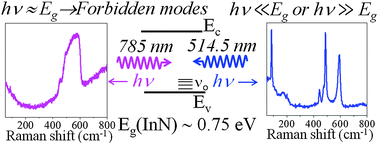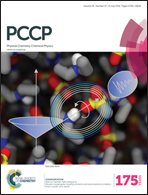Excitation dependent Raman studies of self-seeded grown InN nanoparticles with different carrier concentration†
Abstract
High quality InN nanoparticles are grown using an atmospheric chemical vapour deposition technique via a self-seeded catalytic approach in the temperature range of 580–650 °C. In this temperature region, the nucleation barrier of InN is overcome by seeding low density In nanoparticles prior to introduction of reactive NH3. Samples with increasing carrier densities are grown, with the help of increasing growth temperature, to understand the role of carrier density in the optical phonon structure. Near-resonance Raman spectra show completely different phonon pictures compared to those for the off-resonance spectra. A Raman forbidden mode of B1(high), because of the possible breakdown of selection rules in the near-resonance conditions, is invoked for the first time. The intensity and frequency of this mode strongly depend on the carrier concentration in the sample. In off-resonance conditions, the A1(LO) mode for the sample with higher carrier concentration is dominated by Fano interference rather than plasmon–phonon coupling. Variation of the intensity of the B1(high) mode is correlated with a band filling effect, which is substantiated by the luminescence studies of the InN samples with different carrier concentrations.


 Please wait while we load your content...
Please wait while we load your content...